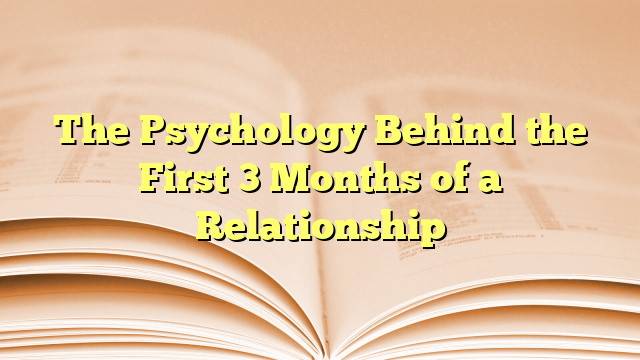The Psychology Behind the First 3 Months of a Relationship
The Psychology Behind the First 3 Months of a Relationship
Introduction
Starting a new relationship can be both exciting and nerve-wracking. The first three months of a relationship are often referred to as the honeymoon phase, where everything seems perfect and the couple is deeply infatuated with each other. However, there is more to this phase than meets the eye. In this article, we will explore the psychology behind the first three months of a relationship and understand why it is such a crucial period.
The Infatuation Stage
During the first three months of a relationship, couples often experience intense infatuation. This is the stage where they are deeply attracted to each other and can’t seem to get enough of one another. The brain releases chemicals like dopamine, oxytocin, and serotonin, which contribute to feelings of pleasure, attachment, and happiness.
During this stage, couples may overlook each other’s flaws and focus only on the positive aspects of their partner. They may feel a strong desire to spend as much time together as possible and may experience a heightened sense of physical and emotional intimacy.
The Role of Attachment
Attachment plays a significant role in the first three months of a relationship. Attachment theory suggests that individuals have different attachment styles based on their early experiences with caregivers. These attachment styles can influence how individuals behave in relationships.
During the honeymoon phase, couples often experience a sense of secure attachment. They feel safe and comfortable with their partner, and they trust that their partner will be there for them. This sense of security allows them to open up emotionally and create a strong bond with each other.
Challenges and Conflict
While the first three months of a relationship are often filled with excitement and happiness, it is not uncommon for couples to face challenges and conflicts during this period. As the infatuation stage starts to fade, couples may start to notice each other’s flaws and differences.
Conflicts can arise due to differences in communication styles, expectations, or values. It is important for couples to learn how to navigate these conflicts effectively and communicate openly and honestly with each other. This period can be a test of the couple’s compatibility and their ability to work through challenges together.
Building Trust and Intimacy
During the first three months of a relationship, couples have the opportunity to build trust and intimacy with each other. Trust is the foundation of any healthy relationship, and it takes time to develop. Couples can build trust by being reliable, keeping their promises, and being open and honest with each other.
Intimacy, both physical and emotional, also plays a crucial role in the first three months. Physical intimacy can deepen the bond between partners and create a sense of closeness. Emotional intimacy involves sharing vulnerable thoughts and feelings with each other, which helps to create a deeper connection.
Transitioning to a Long-Term Relationship
After the first three months, the honeymoon phase starts to fade, and couples begin to settle into a more realistic and stable phase of the relationship. This is where they start to see each other’s flaws more clearly and have a better understanding of each other’s needs and expectations.
Transitioning to a long-term relationship requires ongoing effort and commitment from both partners. It involves accepting each other’s imperfections, compromising, and working together to build a strong foundation for the future.
Conclusion
The first three months of a relationship are a crucial period that sets the tone for the rest of the relationship. It is a time of intense infatuation, building trust and intimacy, and navigating challenges and conflicts. Understanding the psychology behind this phase can help couples navigate it more effectively and set the stage for a healthy and fulfilling long-term relationship.

